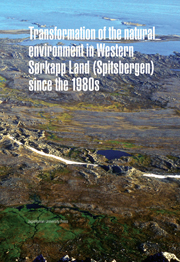Book contents
Waters
from Components of natural environment
Published online by Cambridge University Press: 05 September 2014
Summary
Karst springs can be found at the foot of Tsjebysjovfjellet on Hornsund Fjord (Pulina 1977; Leszkiewicz 1982) in the northeastern corner of the study area. Gåshamnøyra plain, a large extramarginal sandur located west of the massif, was formed by streams from both Gåsbreen glacier and the valley south of the glacier's front edge. These streams flow across the glacier's marginal zone built mainly of dead ice undergoing rapid melting.
Non-glacial rivers and lakes play an important part in the western Sørkapp Land water system. This is not true elsewhere in Spitsbergen. The rivers and lakes in western Sørkapp Land are supplied directly by atmospheric precipitation – including snow patches, which thaw before the following winter – and an active layer of permafrost. This is especially true of the northern part of the study area due to a complete lack of glaciers there. The largest body of fresh and clean water is Svartvatnet lake (Fig. 6), which is found in a deep glacial erosion trough. The lake's water table is found at an altitude of 72 m above sea level. The lake contains a population of Salvelinus alpinus L. salmonoid fish (Gullestad, Klemetsen 1997). Two streams flow into the lake: (1) a main stream, which flows from the snow patch located in the pass (at almost 200 m) between the Lidfjellet and Kovalevskifjellet massifs, and (2) a lateral stream flowing from Kovalevskidalen valley.
- Type
- Chapter
- Information
- Transformation of the Natural Environment in Western Sorkapp Land (Spitsbergen) since the 1980s , pp. 39 - 42Publisher: Jagiellonian University PressPrint publication year: 2011

